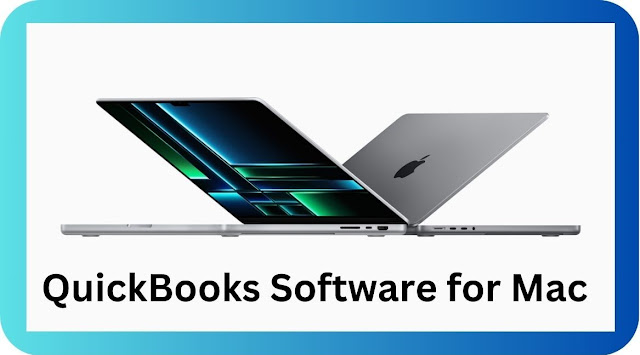How to Use QuickBooks Software for Mac to Maximize Efficiency and Productivity
Welcome to the world of QuickBooks Software for Mac! If you're a Mac user looking to streamline your business finances and boost productivity, you've come to the right place. In today's fast-paced digital era, having reliable accounting software is essential for any small or medium-sized enterprise. And with QuickBooks' powerful features tailored specifically for Mac users, managing your financial tasks has never been easier. Join us as we dive into this comprehensive guide on how to leverage QuickBooks Software for Mac and unlock its full potential in maximizing efficiency and productivity. Get ready to revolutionize your business operations – let's get started!
What is QuickBooks Software?
QuickBooks is a software program designed to help small businesses manage their finances. The program is easy to use and can be customized to fit the specific needs of each business. QuickBooks can track income and expenses, create invoices and reports, and manage payroll. The software also includes a built-in tax calculator to help businesses stay compliant with tax laws. QuickBooks is available in both desktop and online versions, making it accessible from anywhere.
Benefits of Using QuickBooks for Mac
There are many benefits of using QuickBooks for Mac, including the ability to manage your finances more efficiently and effectively. QuickBooks for Mac is designed specifically for businesses that use Apple computers, so it integrates seamlessly with other Apple products and services.
QuickBooks for Mac offers all of the features and functionality of the Windows version of QuickBooks, but is optimized for use on a Mac. This means that you'll be able to take full advantage of all the features and benefits of QuickBooks, without having to worry about compatibility issues.
QuickBooks for Mac is also easier to use than the Windows version, thanks to its intuitive interface. Even if you're not familiar with accounting software, you should be able to figure out how to use QuickBooks for Mac with ease.
QuickBooks for Mac is an excellent choice for businesses that need a powerful and easy-to-use accounting solution. If you're looking for a way to improve your financial management and boost your productivity, QuickBooks for Mac is definitely worth considering.
Setting Up Your Account in QuickBooks for Mac
Assuming you’ve already downloaded QuickBooks for Mac, the first thing you need to do is set up your account. The account set-up process is different than it is for Windows, so be sure to follow these instructions closely.
To set up your
account:
1) Open QuickBooks and select Create a new company.
2) Enter your business information, including company name, address, and contact information.
3) When prompted, enter your industry type. This will help QuickBooks generate accurate reports for your business.
4) Choose whether to use Express Start or the Custom Start option. Express Start is recommended for businesses that are just getting started with QuickBooks, while Custom Start provides more options for businesses that have been using QuickBooks for a while.
5) Select the template that best suits your business needs. You can always change this later if necessary.
6) Enter your financial information, including bank account and credit card information.
7) Set up users and permissions. Only people who need access to QuickBooks should have user accounts; otherwise, you run the risk of unauthorized individuals accessing sensitive financial data.
8) Review and confirm your settings before exiting the account set-up process.
Managing Your Finances with QuickBooks for Mac
QuickBooks software for Mac is designed to save you time and money by making it easy to track your finances. With QuickBooks, you can easily see where your money is going, stay on top of bills and invoices, and manage your budget.
QuickBooks can help
you manage your finances in a number of ways:
· Tracking expenses:
QuickBooks makes it easy to track your business expenses so you can see where your money is going. This can help you identify areas where you may be able to save money.
· Billing and invoicing:
QuickBooks can help you stay on top of your bills and invoices so you don't miss a payment. This can help you avoid late fees and keep your business finances in order.
· Managing your budget:
QuickBooks makes it easy to create and manage a budget for your business. This can help you stay on track with your financial goals and make sure you are not overspending.
Analyzing Financial Data with QuickBooks for Mac
QuickBooks for Mac is a versatile financial analysis tool that can help you track your spending, budget for upcoming expenses, and see where your money is going. By entering your financial data into QuickBooks, you can get a clear picture of your overall financial health and make informed decisions about your spending.
QuickBooks offers a number of features that make it an ideal tool for financial analysis. For example, you can create customized reports to track your income and expenses over time. You can also use the software to set up budgets and track your progress towards financial goals. QuickBooks makes it easy to see where your money is going and identify areas where you may be able to save.
If you're looking for a way to take control of your finances and make more informed decisions about your money, QuickBooks for Mac is a great option. With its easy-to-use interface and powerful financial analysis tools, QuickBooks can help you maximize efficiency and productivity while keeping track of your spending.
Creating Customized Reports in QuickBooks for Mac
QuickBooks for Mac has a number of built-in reports that can be customized to suit your business needs. To create a custom report, first select the type of report you want to create from the "Reports" menu. Then, click the "Customize" button in the top toolbar.
In the "Customize Report" window, you can specify the date range, filter criteria, and other options for your report. Once you've made your selections, click "OK" to generate the report.
QuickBooks for Mac also allows you to save your customizations so that you can quickly generate similar reports in the future. To do this, click the "Save Customization" button in the "Customize Report" window. Give your customization a name and description, then click "Save."
Integrating Other Applications and Services into QuickBooks for Mac
As a business owner, you are always looking for ways to streamline your operations and increase productivity. QuickBooks for Mac is a powerful accounting software that can help you manage your finances more efficiently. But QuickBooks is not just an accounting tool—it can also be used to integrate other applications and services into your business.
Here are some of the
most popular applications and services that can be integrated with QuickBooks
for Mac:
· CRM software:
Customer relationship management (CRM) software helps you track and manage your customer relationships. QuickBooks for Mac can be integrated with popular CRM software such as Salesforce, Zoho CRM, and HubSpot CRM. This integration will allow you to sync your customer data between QuickBooks and your CRM software, making it easier to keep track of your customers’ contact information, purchase history, and communication.
· Invoicing software:
Invoicing software allows you to create and send invoices electronically. QuickBooks for Mac can be integrated with invoicing software such as FreshBooks, Wave Accounting, and ZipBooks. This integration will save you time by automatically creating invoices in QuickBooks when new orders are placed in your invoicing software.
· Payment processing:
QuickBooks for Mac can be integrated with payment processors such as PayPal, Stripe, and Square. This integration will allow you to accept online payments from your customers directly through QuickBooks. You can also use this integration to automatically process payments when invoices are paid.
· E-commerce platforms:
If you sell products online, QuickBooks for Mac can be integrated with popular e-commerce platforms such as Shopify, Bigcommerce, and WooCommerce. This integration will sync your sales and inventory data between QuickBooks and your e-commerce platform, making it easier to keep track of orders and stock levels.
· Project management software:
Project management software enables teams to collaborate on projects more efficiently. QuickBooks for Mac can be integrated with project management software such as Asana, Trello, and Basecamp. This integration will allow you to sync tasks between QuickBooks and your project management software, making it easier to manage projects in one place.
Troubleshooting Common Issues with QuickBooks for Mac
If you're having trouble with QuickBooks software for Mac, there are a few common issues that you can troubleshoot. First, make sure that you have the latest version of QuickBooks installed. You can check for updates by going to the QuickBooks menu and choosing Check for Updates.
If you're still having trouble, try restarting your computer. Sometimes QuickBooks can become unresponsive if it's been running for a long time. A restart will usually fix the problem.
If you're still having problems, try contacting QuickBooks
support. They should be able to help you resolve any issues you're having.
Conclusion
QuickBooks for Mac offers an intuitive and versatile accounting software that makes it easier to manage your business’ finances. With all the features, integrations, and customizations available, using QuickBooks for Mac can help maximize efficiency and productivity in any business. Even if you are not familiar with how to use the software yet, there is a learning curve that can be overcome through practice or by seeking out tutorials online. By taking advantage of this powerful tool, businesses can greatly improve their financial management capabilities.




Comments
Post a Comment